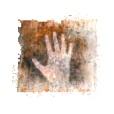Please wait a few moments while we process your request

Steina and Woody Vasulka
Voice Windows, 1986 (with Joan La Barbara)
With Voice Windows (1986), Steina renews her efforts to generate a complex sound-image interface. She had already attempted this with Violin Power (1970-1978) a video in which she used a specially adapted violin to simultaneously transform the electronic signal and sound wave of a video image. In Voice Windows, Steina experiments with keying video tracks that visually convey the modulations of the human voice. For this experiment, Joan La Barbara, an American singer and composer, provided a repertoire of samples featuring all the registers of her voice.
These samples are processed through a software that syntonizes the frequency levels with a secondary video track. This track is then keyed into a primary track whose contour matches the changes of timbre and tone of the voice. At the start of the video, blue lines waver on a black background, denoting the sound modulations. These lines seem to open a gap in the first image, evoking the window from the video's title.
Next, a dolly shot on a street replaces a monochrome background, and the track modulated by the voice reveals a second landscape. The continual shifting between these two layers makes it impossible to gain a real sense of depth. Indeed, the keyed track keeps the viewer's eyes on the surface of the screen. Voice Windows is part of a cycle of videos and installations inspired by the New Mexico desert. In these works, the landscape serves as a foundation for experimenting with the features that distinguish electronic images.
Joan La Barbara used a bank of images taken from Voice Windows in her performance Vocal Window presented in 1987 at Santa Fe's Center for Contemporary Art. In this piece, Joan La Barbara manipulated the real-time video segments using Interactor, a software developed by Mark Coniglio and Morton Subotnick. Segments of this performance also appeared in the multi-screen installation Vocalization, created by Steina in 1990.
These samples are processed through a software that syntonizes the frequency levels with a secondary video track. This track is then keyed into a primary track whose contour matches the changes of timbre and tone of the voice. At the start of the video, blue lines waver on a black background, denoting the sound modulations. These lines seem to open a gap in the first image, evoking the window from the video's title.
Next, a dolly shot on a street replaces a monochrome background, and the track modulated by the voice reveals a second landscape. The continual shifting between these two layers makes it impossible to gain a real sense of depth. Indeed, the keyed track keeps the viewer's eyes on the surface of the screen. Voice Windows is part of a cycle of videos and installations inspired by the New Mexico desert. In these works, the landscape serves as a foundation for experimenting with the features that distinguish electronic images.
Joan La Barbara used a bank of images taken from Voice Windows in her performance Vocal Window presented in 1987 at Santa Fe's Center for Contemporary Art. In this piece, Joan La Barbara manipulated the real-time video segments using Interactor, a software developed by Mark Coniglio and Morton Subotnick. Segments of this performance also appeared in the multi-screen installation Vocalization, created by Steina in 1990.
Vincent Bonin © 2001 FDL
Index:
- Steina and Woody Vasulka Fonds
• Presentation
• Works by Steina and Woody Vasulka
• Works by Woody Vasulka
• Works by Steina - Yvonne Spielmann, Video and Computer
• Introduction
• Image as process
• The Reflexive Medium
• The Reflexive Medium (cont'd)
• The Matrix of Electronic Languages
• Image Becomes Object
• The Art of Intervention
• Conclusion
• Description of works
• Selection of tools
Related page:
 Rutt/Etra Scan Processor
Rutt/Etra Scan ProcessorWhen he met Steve Rutt in the early seventies, Bill Etra was completing a residency at the WNET Thirteen Laboratory (New York, U.S.).


